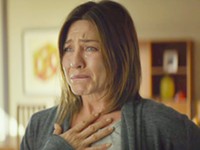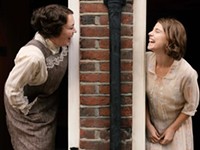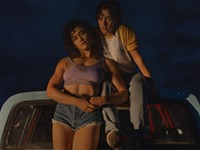[
{
"name": "500x250 Ad",
"insertPoint": "5",
"component": "15667920",
"parentWrapperClass": "",
"requiredCountToDisplay": "1"
}
]
Devotees of horror recall the original Texas Chainsaw Massacre (1974) with that peculiar mixture of terror and delight that distinguishes the genuine student of the form from the mere shudder-seeking dilettante. Though made by virtual unknowns, most of whom, with the exception of its director and co-writer Tobe Hooper, are now forgotten, and on a shoestring budget, the picture earned an enormous amount of money and attracted a huge international following. More important, it explored new territory in its genre, blazed a twisted trail through the dark and tangled forests of fear, guiding the way to a whole generation of imitations, replications, and sequels.
The latest version, currently one of the top grossers in the country, pretty much duplicates that now ancient model. It provides more elaborate production values than the relatively crude and somewhat amateurish original, thickening the straightforward plot with a hint of emotional complication and a minimal bit of back story. In keeping with the advances in audience appetite, it also heightens the sadism, fright, and gore even beyond the usual levels associated with our enlightened time. The result, still very closely resembling its grand prototype, obviously pleases large numbers of moviegoers, a whole new generation eager to witness once again the terrible trouble young folks could get into back in Texas in 1973.
While sticking closely to the basic plot and the documentary premise, the new movie changes a few details, mostly in order to exploit more fully its ghoulish mixture of graphic violence and sick humor. A party of five young people traveling through Texas in a van pick up a disoriented girl who babbles incoherently, then pulls out a pistol and kills herself, blowing a large hole in her head that the camera lovingly and repeatedly peers through, raising voyeurism to a new level.
Naturally panicked, they stop at some rough draft of a rural service station-diner-pork butcher to inform the authorities, a process that leads them to the old house where the famous Leatherface practices his crude surgeries, and a sadistic sheriff right out of some nightmare of rural Southern justice.
From its opening moments the movie throbs with menace, reminding us that suspense consists more of when rather than what, so that the audience will grow ever edgier with anticipation of the inevitable events they know must follow. In keeping with the conventions of modern horror, the camera, accompanied by ominous music, dwells on numerous commonplace objects, investing them with a peculiar power, as if each doorknob or window or kitchen utensil presented some special danger, creating a world in which even the ordinary and the everyday seethe with menace.
Following another tradition, the movie's moral scheme at least suggests a certain logic in its extreme punishment for some trivial actions, like picking up hitchhikers, entering strange houses uninvited, and smoking pot, but mostly simply for having the bad luck to drive down a particular road at a particular time and so encountering an inexplicable horror.
Aside from its groundbreaking depiction in loving and lifelike detail of an entirely new and terribly savage kind of cinematic violence --- mutilation, dismemberment, decapitation, evisceration, cannibalism, etc. --- the original film introduced that now legendary weapon of choice, the lumberjack's friend of the title. When Leatherface once again revs up the old Black & Decker, fans of the genre should experience a specialthrill, the frisson of a connoisseur hearing the opening notes of some great symphony, perhaps. Some sinful pleasures, no matter how bizarre, must be experienced to be forgiven.
The real subject of both the original Texas Chainsaw Massacre and the update remain, however, a more common and pervasive dread than any monster chopping up and flaying his victims. The movie confronts, in even more nauseating detail than its surface actions, a disquieting vision of what Karl Marx calls "the idiocy of rural life." The picture captures with a cruel and terrible accuracy the parched fields of Texas scorching under an August sun, the decrepit trailers, the old automobiles rusting in farmyards, the decayed barns and mills, the dingy interiors of old, empty houses, the ancient, concentrated filth of a backyard privy.
The movie exhibits that world with a special brilliance, making it simultaneously real and repulsive, so that one can almost smell the putrid meat, the dusty air, the moldy furniture, the old houses, the rotting carpets, all frighteningly familiar to anyone who's been there.
The people who inhabit that world behave with a hostility and viciousness that belies the Romantic notion of the nobility of peasant life. They demonstrate in their physical and emotional reactions to the outsiders the perils of isolation and inbreeding, far more lethal and terrifying than the brutality of some menace or monster. The Texas Chainsaw Massacre achieves its true horror in its representation of those characters and their environment. In comparison to that, the violent hillbillies of Deliverance look like urban sophisticates.
The Texas Chainsaw Massacre, starring Jessica Biel, Jonathan Tucker, Erica Leerhsen, Mike Vogel, Eric Balfour, David Dorfman, R. Lee Ermey; screenplay by Scott Kosar; based on a screenplay by Kim Henkel and Tobe Hooper; directed by Marcus Nispel. Cinemark Tinseltown; Hoyts Greece Ridge; Loews Webster; Regal Culver Ridge; Regal Eastview; Regal Henrietta.
You can hear George and his movie reviews on WXXI-FM 91.5 Fridays at 7:20 a.m., rerun on Saturdays at 8:50 a.m.
Latest in Movie Reviews
More by George Grella
-

Film Review: "Cake"
Jan 26, 2015 -

Film Review: "American Sniper"
Jan 19, 2015 -

Film Review: "Inherent Vice"
Jan 12, 2015 - More »






